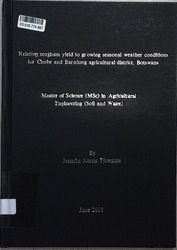| dc.description.abstract | Growing season rainfall is the most important factor in rain-fed arable agriculture in semi-arid
climates. Knowledge of rainfall distribution is needed to make farmers aware of possible crop
yield obtainable during and at the end of growing season and also help governments with
information for the attainable of food security. The goal of this study was to examine the
relationship between crop yield and growing season rainfall distribution in an attempt to
contribute to food security early warning system. Specifically, the study determined the
relationship between total seasonal rainfall, total number of rainy days, average maximum
temperature and sorghum yield. The established relationship was then used to determine the most
sensitive growth stage (s) for yield loss. The study explored the relationship between seasonal
rainfall distribution and total seasonal rainfall with crop yield for Chobe agricultural district and
Barolong agricultural sub-district In genera), seasonal rainfall showed a negative slope while
sorghum yield had a positive gradient for Chobe agricultural district. For Barolong agricultural
sub-district, a positive trend was observed in both seasonal rainfall and sorghum yield. Number
of rainy days and sorghum yield indicated a positive slope for Chobe agricultural district while
for Barolong agricultural sub-district, a negative slope in rainy days was observed while sorghum
yield had a positive gradient. Exploratory results show that sorghum yield fluctuated with
rainfall. Over the years, rainfall and sorghum yield fluctuated for both districts. Average
maximum temperature at flowering stage had high correlation with sorghum yield (0.62) for
Chobe agricultural district. For Barolong agricultural sub-district, the following showed high
correlation with sorghum yield; total rainfall amount at maturity (0.85), total number of rainy
days at pre-sowing stage (0.79) and total number of rainy days at maturity stage (0.72). There
were no differences in sorghum yield for both districts because both confidence limits at 95%
include the mean of sorghum yield for the respective study periods. Temperature at flowering
stage was the only significant (P < 0.02) explanatory variable for yield for Chobe. For each
degree Celsius increase in average maximum temperature at flowering stage, sorghum yield
increased by 0.223 kg/ha for Chobe agricultural district. If there was no influence of average
maximum temperature at flowering stage, yield would be less 5.483 kg/ha. For Barolong, rainy
days at pre-sowing stage (P <0.02), rainy days at maturity stage (P < 0.002), and rainfall amount
at maturity stage (P < 0.02) were significant. For each increase in number of rainy days at pre
sowing stage, yield decreased by 0.829 kg/ha while at maturity stage, an increase in a number of
rainy days, decreased sorghum yield by 3.376 kg/ha. An increase in rainfall at maturity stage
increased sorghum yield by 0.912 kg/ha. The most sensitive stage (s) for sorghum grain yield
loss due to high rainfall experienced in Chobe agricultural district was the flowering stage, with
maximum temperature being the limiting factor while for Barolong agricultural sub-district were
the pre-sowing (rainfall distribution more than enough) and maturity stages (total rainfall
amount limiting and rainfall distribution more than enough). | en_US |

